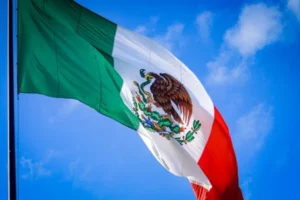Location
The area or neighborhood of Xochimilco is located 43 km from the historic center of Mexico City. Its name in the Nahuatl language means “field of flowers” or “place of the flowery sementera”. This beautiful site described as “place of floating gardens” dates back to pre-Hispanic times. This place remembers how the old Valley of Mexico, Tenochtitlan area, was a place settled on lagoons being an important part of its culture and way of life. With the passage of time the Lake of Xochimilco regressed considerably, intervened by its inhabitants for the creation of the chinampería, portions of land flooded by a complex system of aqueducts and that would be settlement of extremely prolific cultivation areas.
Xochimilco was definitively integrated into the metropolitan area of CDMX in 1970 when the extension of The North Division Avenue and the Peripheral Ring was built. That is why it is still one of the most visited tourist destinations in Mexico City.
The Chinampas, Forms of Ancestral Cultivation
The southern area of Xochimilco was furrowed by rainwater channels and its inhabitants developed a form of agriculture called chinampas in swampy areas of the shallow lagoon. With the aim of gaining ground to the water, in ancient times they introduced earth rafts to convert their canals into cultivation sites, being very prosperous for being fertile land, with a system of aqueducts and with good weather throughout the year.
At the time of the conquest they were preserved as the main economic activity, enduring over time to this day. Floriculture, brought to these lands by its first settlers, was consolidated. The commercialization of various flowers, ornamental plants and vegetables has become the main source of employment for the locals. The color of the same adorn its channels with a unique chromatic showiness, constituting a rejoicing walk for the tourist.
There is no visitor who resists buying them as souvenirs. Today it is the main commercial activity in the area. Such is the cult that the native of Xochimilco has for flowers that it is tradition to organize annually the beauty contest “the most beautiful flower of the Ejido”. The community chooses a beautiful native representative and is entertained with traditional and indigenous dances in honor of Xochiquetzal, goddess of flowers and beauty.
Walks in Trajinera.
Although the peasant always moved sailing through its canals, it was only in the last quarter of the nineteenth century during the time of the government of General Porfirio Díaz (Porfiriato), where it became common and frequent to transfer in trajineras in a recreational way, assigning names to the boats in order to honor someone or as a gesture of courtship towards a lady. Within the anecdote are remembered the usual walks made by the famous artists Diego de Rivera and Frida Khalo aboard one of those boats, iconic characters of Mexican culture, symbols of free and unconditional love that both professed.
The so-called Catrines or very elegant dressed men frequented Xochimilco to make these walks. The fame of these tours in the trajineras by the chinampas in Xochimilco rose like foam, becoming its greatest tourist attraction where approximately 184 kilometers of water roads are traveled.
The barges were decorated with arches of multicolored flowers and ahuejote foliage tied with tules, in addition to building the roofs to protect their occupants from the sun and have chairs for greater comfort of those who make the walk through its canals. This allowed the visitor to admire more comfortably the beauty of the “gardens” of Xochimilco.
At the beginning of the twentieth century its areas were expanded with the construction of ten piers and markets. The traditional piers widely recommended are Cuemanco, Nativitas, Zacapa and Las Flores Nativitas which have extensive tourist services such as restaurants, parking lots and craft markets. Here the Manantiales restaurant stands out, for the beauty of the structure that houses it. Also nearby is the Nativitas Forest, a wooded area that has become the favorite place for residents where they ride horses, with picnic areas where barbecues are made. There is also the Honeysuckle market where flowers and plants are sold.
Ecological reserve site
In addition to the historical value that Xochimilco represents since it allows us to delve into the ways of life of the ancient pre-Columbian inhabitants, it also constitutes an ecological reservoir of unique species, plants, animals such as the axolotl salamander, the Moctezuma frog and native Mexican trees such as the ahuejote present in the fences of the canals and in the trajineras. It is of special mention the piers Fernando Celada, Cuemanco and Puente de Urrutia since in their properties they navigate through the protected natural area, a quiet environment where endemic birds live passing through sites of great ecological value.
Monuments and sites of interest
Among the places of interest to visit is the Temple and Convent of San Bernardino de Siena built in the sixteenth century by Franciscan missionaries. It is part of an architectural complex that also includes a school where indigenous children were educated. Around this building there are different manifestations and celebrations. Every Sunday in honor of the “Niño Pan” and in May San Bernardino is celebrated with dances, theater, mechanical games and sale of native food.
The Archaeological Museum of Xochimilco, inaugurated in 1985, offers you an exhibition of Teotihuacan pieces of mud and stone as well as collections of objects of paleontological origin.
The Dolores Olmedo Patiño Museum, named after the collector who dedicated herself to protecting and disseminating the work of the artists Diego de Rivera and Frida Khalo, has a collection of more than 3000 works in traveling exhibitions as well as 600 pre-Columbian pieces from the Mesoamerican region of Olmec, Mixtec, Totonac, Zapotec, Aztec, Mayan and Toltec origin. It is located within the farm La Noria, structure of the S. XVII.
In addition to the 15 churches built throughout Xochimilco and its chinampera area, it is also worth mentioning the ejidos, San Gregorio Atlapulco, San Luis Tlaxialtemalco and its lake as a zone of protection of flora and fauna. Also its historical and religious center where the temples and buildings that give great commercial mobility to the central place of Xochimilco are located.
In the old ceremonial center Xochimilco was built the Rotunda of the Illustrious Characters of Xochimilco, with interior gardens that invite you to rest and modern architecture. On its walls stands out the writing of the royal decree delivered by Felipe II Rey de España where he titles Xochimilco a noble and royal city.
It is also an obligatory reference to approach the Island of the Dolls, site of great tourist affluence. Its story tells the legend of a young woman who drowned among the lilies being her body found next to the chinampas of Mr. Julian. His spirit from that moment was wandering in the place and frightened he decided to hang dolls in his chinampas that he found in the garbage and in the canals. According to Julián Santana this served to frighten the spirits and bear fruit the harvests.
The Teuhtli volcano is a natural monument that serves as a boundary between the municipalities of Milpa Alta, Tláhuac and Xochimilco. It is an alternative to hiking on its slopes. The populations that live in its skirts make pilgrimages on the day of the Holy Cross to worship the one that was perched on its top.
Cerro Cuahilama is an archaeological site of importance located near the Archaeological Museum of Xochimilco. In ancient times it was a cult center located in the Cuahilama neighborhood where pieces sculpted in basalt stone were found. The archaeological discoveries express that there lived settled Mexican communities that probably worshiped the sun god for the existence of an observatory and a ceremonial center to celebrate fertility.
The findings of ten pre-Hispanic petroglyphs in the vicinity of its slopes are famous, which had functions of worship and worship. They are shapes that represent stars and figures related to fertility. There were also cultivation terraces and rooms that were presumably for priests who officiated the ceremonies.
The Xochimilco Ecological Park was declared a World Heritage Site in 1987 by UNESCO. It occupies 165 hectares of surface being in it two types of landscape, one aquatic with chinampas and the other humid forest. It is an important ecological reserve.
Xochimilco, Chisel Of Traditions
Xochimilco will be an experience full of tradition and culture. It hosts more than 400 traditional and patron saintly manifestations held in the year, highlighting its cultural vitality and the deep roots and love that each inhabitant manifests for their land. Popular festivals such as Day of the Dead and Child Stewardship and trade fairs such as Snow Fair, Joy and Olive Fair and Crystallized Sweet Fair. In these fairs each producer puts on the table the best to offer the visitor under a pleasant atmosphere of music and color, enlivened with theater and dances. In transit through its canals you will find chalupas or boats occupied by mariachis that offer their music to the visitor. As well as marimba, street vendors of snacks, fruits and flowers as marketed by the ancient locals.
In the first quadrant of the area you will find the Xóchitl market in the El Rosario neighborhood. It is one of the oldest whose foundation dates back to the sixteenth century. It is famous because it offers a varied offer of products that adorn the local gastronomy: milpa soup, tuna xoconochtle, nopales and epazote, dressings for cuatatapas based on beans; and the tlapique, a kind of tamal stuffed with fish and wrapped in totomoxtle leaves. You will also get exotic species and flowers achieved in greenhouses in the Flower and Plant Market.
If you want to get in touch with the most indigenous Mexican way of life, you must have a mandatory stop in Xochimilco. Its worldview, culture and ancestral values have remained intact thanks to the work of its inhabitants, which is why it was named a Cultural Heritage of Humanity in 1987 by UNESCO.
This appointment is also a recognition of the human creativity of its ancient inhabitants, in terms of manipulating a natural site to create favorable conditions for cultivation: fertile land, water availability and intensive agricultural production.
Despite being far from the city you will always have tracks and means of access either by bus, car, train, metro, light rail. So you are invited to enjoy the great cultural diversity that Xochimilco offers, where the past and the present merge into a wonderful and magical symbiosis.










